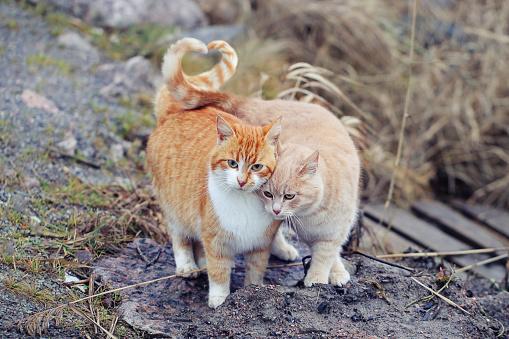Your cat’s tail can tell you a lot about what sort of mood your cat is in. I love studying my cats and watching them for a long period of time. I find I am learning more about them through their body language which helps me understand them better. I love watching people too as their body language is equally as interesting and tells me much about our society.
Your cat’s tail can move in so many different ways. There is the gentle twitch Cassie uses when she is eating. Then there is the slow ‘tail wave’ when she is lying on my lap being petted. She will often speed up the wave or make it stronger if I’m doing some cross stitch or reading and not paying enough attention to her. She will also lay her tail on top of the book to make me stop reading so I can pay more attention to her. This is a deliberate action on her part.
Cat body language is fascinating. So is the body language of any animal, including humans, which is why I love studying them. And the tail is a special part of cat body language and a wonderful tool that they use to communicate with us.
If you notice your cat’s tail all fluffed out, she is most likely frightened or angry and trying to make herself look bigger. Usually the fur will be standing on end for the same reason. If the tail is standing up straight, your cat is happy and content, while a low hanging tail between the legs means she is unhappy about something or being submissive to an alpha cat. One that is waving from side to side at an angle means she could be derisive and not interested in you at all at the moment. It is the cat equivalent to being ‘given the finger’ from a surly and unco-operative teenager.
A hooked tail means your cat wants to be friends but is not really sure about you, and one that is straight and pointing out at a 45 degree angle is showing another cat that she doesn’t feel threatened but doesn’t really know the newcomer. She is prepared to be friends when the tail is at this angle.
If your cat is sitting and the tail is thrashing from side to side, she is telling you that she is either excited, angry or irritable. You will need to be careful and watch for other body language cues such as hissing or flattened ears. If the tail is merely twitching when she is sitting, it means she is alert and interested in what is going on around her. This could be a good time to start playing with her or to teach her a new trick.
A tail that is angled down means your cat could become aggressive and if you notice that the tail comes out straight for a bit before angling down, be careful as that means she feels cornered or defensive and could quickly become aggressive and attack.
I love to see my cat’s tail standing straight out to the back as this means my cat is in a good mood. She is not feeling aggressive or worried about anything, life is treating her well. Even better is seeing her tail straight up and quivering slightly as this means she is happy to see me.
Study your cat as often as you can. You can learn a lot of things about their mood just by watching their body language, especially the language of the tail. And I suggest you teach these tail movement meanings to your children as early as possible. It could help prevent scratches and bites if they understand when to back away from an angry cat. You will be amazed at how much cats use their tails to communicate.




